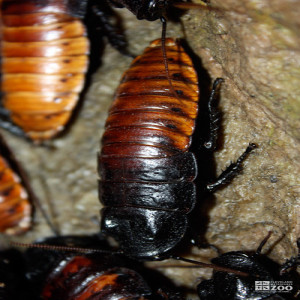Madagascar Hissing Cockroach
[Gromphadorhina madagascarensis]

The Madagascar Hissing Cockroach can have a length of up to 3 inches. Their coloration is dark brown, and the body is segmented. This species has special breathing pores along the sides of its body. This hissing sound is caused by air being expelled through these pores, and can be heard up to 12 feet away. The hissing sound is produced by males courting or battling for territory, and also gently by a female becoming receptive to a mate.
The Madagascan cockroaches are so fastidious that they seem unlikely to ever invade human quarters. Entomologists keep them as pets, wondering if anything could be added to their diet to induce them to grow wings. Well-fed adults have already developed short, blunt horns, which seems unusual for insects so eager to avoid confrontation. They have biting and chewing mouth parts, and teeth in their gizzard.
No cockroach species is parasitic or poisonous. Fossil cockroaches have been found dating back to 280-350 million years ago. They have persisted because of their flexible eating habits, their ability to adapt, their flat body which enables them to hide in narrow places, and the strong muscles in their legs which enable them to run rapidly. They are also wingless and good climbers. Median Life Expectancy is 2-5 years.
Location: Animals Formerly at Zoo
Share:
Range
The range of the Madagascar hissing cockroach is the Island of Madagascar.
Habitat
Rotting LogsConservation Status
Least ConcernPrimary Threats
Gestation
Madagascar cockroaches incubate their eggs in about 55 days.
Litter
Behavior
Cockroaches are nocturnal insects. They depend primarily on sense organs – antennae for detecting odor, and tibiae, which respond to vibration – to find food and avoid predators. Most cockroaches also have sensitive projections, called cerci, at the posterior end of their bodies, which alert the insect to movement too far behind them to be detected by the antennae. Fossil cockroaches have been found dating back to 280 to 350 million years ago. They have persisted because of their flexible eating habits, their ability to adapt, their flat body which enables them to hide in narrow places, and the strong muscles in their legs which enable them to run rapidly.
Reproduction
Females appear to bear living young, but nymphs emerge from an egg case called ootheca that remains inside the cockroaches body until hatched. Nymphs molt six times through a period of 5 months after which they become sexually mature. Adults do not molt.Wild Diet
The hissing cockroach is omnivorous. It will eat nearly anything, including the sick and dead of their own species.
